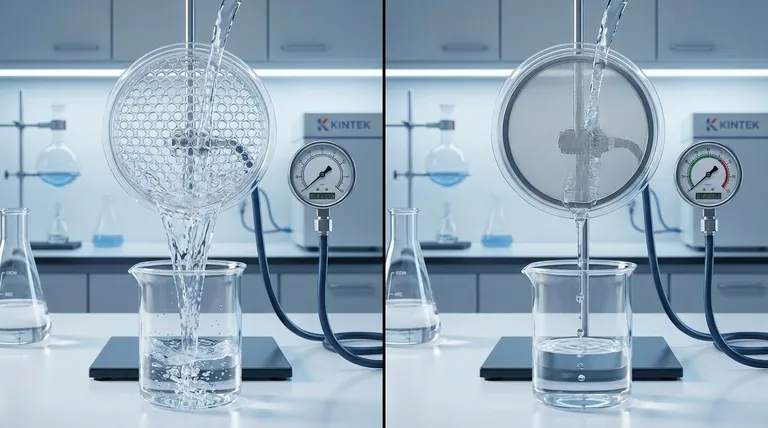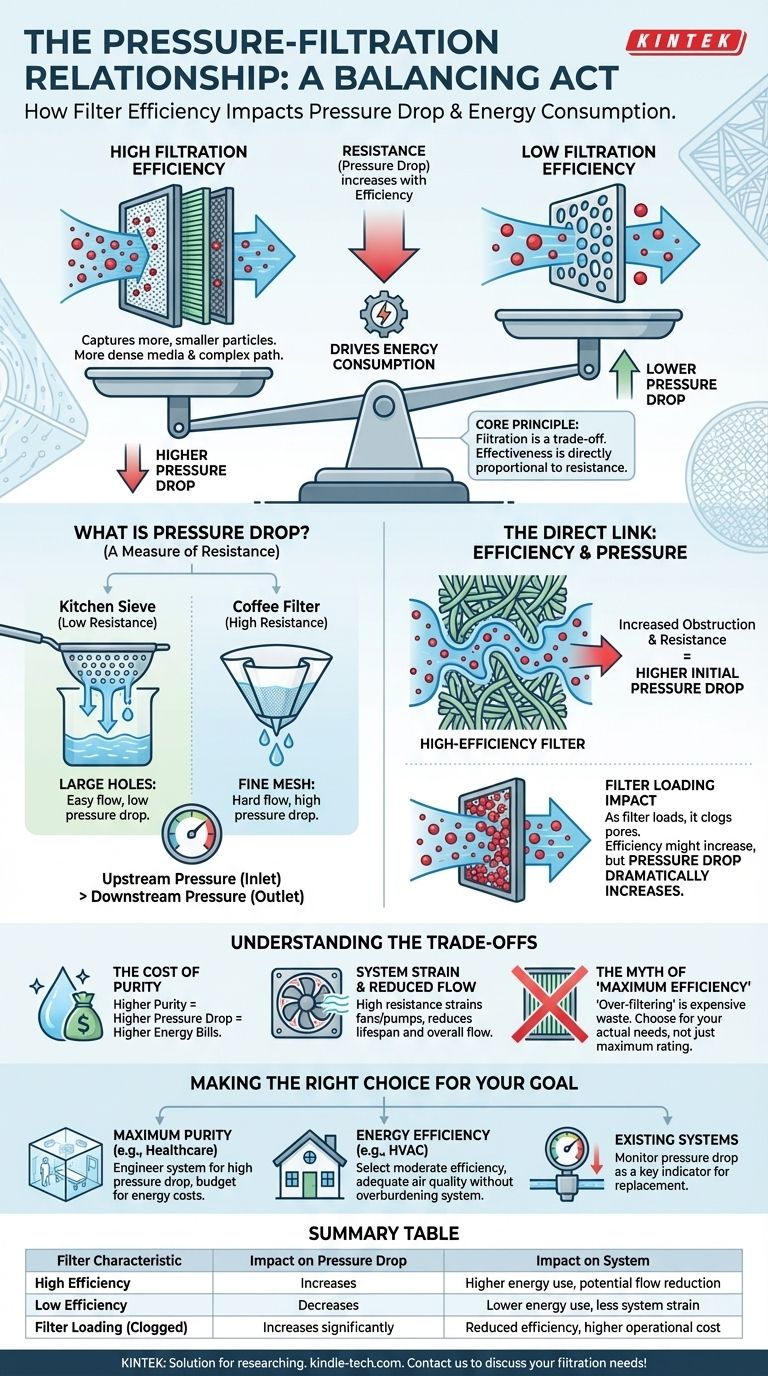In filtration, pressure and efficiency are fundamentally linked. A higher filtration efficiency invariably results in a higher pressure drop. This means the more effective a filter is at capturing small particles, the more resistance it creates to the flow of the fluid (like air or water) passing through it, forcing your system to work harder.
The core principle to understand is that filtration is a balancing act. The effectiveness of a filter at capturing contaminants (its efficiency) is directly proportional to the resistance it creates (pressure drop), which in turn drives energy consumption and system performance.

What is Pressure Drop?
A Measure of Resistance
Pressure drop is the difference in pressure measured between the upstream (inlet) side and the downstream (outlet) side of a filter. It is the most direct way to quantify how much resistance a filter adds to a system.
An Intuitive Analogy
Think of pouring water through a kitchen sieve. A sieve with large holes allows water to flow through with little resistance—this is a low pressure drop. A sieve made of very fine mesh, like a coffee filter, requires more force to push the same amount of water through in the same amount of time. This resistance is a high pressure drop.
Why It Matters
A high pressure drop signifies that the system's fan or pump must exert more energy to move the fluid through the filter. This directly translates to higher energy consumption and can reduce the overall flow rate if the system isn't powerful enough to overcome the resistance.
The Direct Link Between Efficiency and Pressure
How High-Efficiency Filters Work
High-efficiency filters are designed to capture extremely small particles. To do this, their internal filter media is either much denser or creates a more complex, tortuous path for the fluid to navigate.
The Source of Resistance
This dense and complex structure, which is essential for capturing microscopic contaminants, naturally creates more physical obstruction. More obstruction means more resistance, leading directly to a higher initial pressure drop compared to a less efficient filter.
The Impact of Filter Loading
As any filter operates, it captures and holds contaminants. These trapped particles begin to clog the filter's pores, which ironically can increase its capture efficiency but also dramatically increases the pressure drop. This is why filters must be changed regularly.
Understanding the Trade-offs
The Cost of Purity
The central trade-off is between the quality of your filtered fluid and the operational cost. Achieving higher purity with a more efficient filter will always demand more energy to overcome the associated pressure drop, leading to higher utility bills.
System Strain and Reduced Flow
Forcing air or liquid through a high-resistance filter can put significant strain on fans, motors, and pumps, potentially reducing their operational lifespan. In systems not designed for it, a high-efficiency filter can starve the system, leading to a noticeable reduction in overall flow.
The Myth of "Always Choose Maximum Efficiency"
Selecting a filter with an efficiency rating that is much higher than what the application truly requires is a frequent and expensive error. This "over-filtering" leads to unnecessary energy expenditure and can negatively impact system performance without providing any tangible benefit.
Making the Right Choice for Your Goal
Ultimately, the correct filter is the one that meets your specific requirements without introducing excessive and costly resistance.
- If your primary focus is maximum purity (e.g., cleanrooms, healthcare): You must engineer the system to handle a high pressure drop and budget for the corresponding energy costs.
- If your primary focus is energy efficiency (e.g., residential HVAC): Select a filter with a moderate efficiency rating that provides adequate air quality without overburdening your system's fan.
- If you are managing an existing system: Monitor the pressure drop across your filters as a key indicator for when they are loaded and require replacement to maintain both efficiency and performance.
Choosing the right filter is about finding the optimal balance between performance and purity for your specific application.
Summary Table:
| Filter Characteristic | Impact on Pressure Drop | Impact on System |
|---|---|---|
| High Efficiency | Increases | Higher energy use, potential flow reduction |
| Low Efficiency | Decreases | Lower energy use, less system strain |
| Filter Loading (Clogged) | Increases significantly | Reduced efficiency, higher operational cost |
Struggling to balance filtration efficiency with system pressure and energy costs? KINTEK specializes in lab equipment and consumables, offering expert solutions to help you select the perfect filter for your specific application—ensuring optimal performance, purity, and cost-efficiency for your laboratory. Contact us today to discuss your filtration needs and let our specialists guide you to a smarter, more effective solution!
Visual Guide

Related Products
- Laboratory Sterilizer Lab Autoclave Pulse Vacuum Lifting Sterilizer
- Laboratory Sterilizer Lab Autoclave Vertical Pressure Steam Sterilizer for Liquid Crystal Display Automatic Type
- Oil Free Diaphragm Vacuum Pump for Laboratory and Industrial Use
- Benchtop Laboratory Vacuum Freeze Dryer
- HFCVD Machine System Equipment for Drawing Die Nano-Diamond Coating
People Also Ask
- Can autoclave sterilize liquid? Master Safe and Effective Liquid Sterilization
- Do you need to autoclave glassware? A Guide to Sterilization vs. Cleaning
- What temperature must be reached for sterilization in 10-12 minutes? Achieve Rapid, Reliable Sterility with Flash Autoclaving
- What is the most common machine used to sterilize medical supplies? The Definitive Guide to Autoclaves
- How do you sterilize glassware by autoclave? Master the 3-Step Process for Reliable Sterility



















